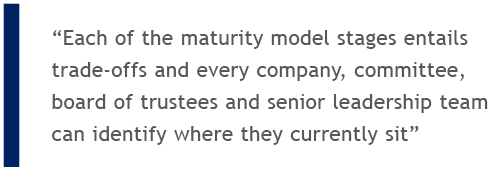Published in Asian-mena Counsel: Legal Innovation & Technology Special Report 2019
By Jay Shaw, Praxonomy
 The tools boards use to communicate should be simple to use, meet their needs (and no more) and be secure.
The tools boards use to communicate should be simple to use, meet their needs (and no more) and be secure.
 Though boards differ considerably in regard to how they communicate with and support their members, the approaches boards adopt to organise meetings, circulate reports (and other documents) and manage minutes and records tend to evolve in predictable ways over time.
Though boards differ considerably in regard to how they communicate with and support their members, the approaches boards adopt to organise meetings, circulate reports (and other documents) and manage minutes and records tend to evolve in predictable ways over time.
This article lists five typical approaches in terms of a board management maturity model and discusses some of the benefits and costs of each. The approaches are:
- Printed Documents
- Emails and Attachments
- Network or Cloud File Storage
- Mass-Market Collaboration Solutions
- Dedicated Board Management Portal Solutions
Not all boards start at the beginning. Neither do all boards move smoothly from one stage to the next. In fact, some boards stay at one stage for decades, some skip stages and some deploy hybrid strategies — ie, email plus network storage — and may never entirely make the jump from one stage to the next. Various factors affect progress, including changing regulatory requirements, willingness to try new technologies, company size and board composition itself, all of which affect the shape and timing of next-step choices.
Nevertheless, there are global commonalities.
For boards currently printing board-books (and many boards still do), print shops are everywhere. The post office is reliable. Most directors are more than capable of carrying stacks of papers into meetings. Many prefer to work with printed documents. On the downside, printed board-books are hard to update (especially at the last minute), tend not to be the best option for the environment and do not lend themselves to a “single source of truth” treatment for record-keeping and audit purposes.
For boards using email attachments, the printing issues are lessened (though not eliminated), delivery is virtually immediate and updates can be distributed via new attachments. However, updates and version control are still problematic and there is growing awareness of the security risks created by the distribution of sensitive documents as email attachments.
For boards using network or online document storage solutions such as Dropbox or DocSend or mass-market collaboration solutions such as Confluence, SharePoint or Slack, board reports and other documents can be stored online and replaced with new versions as required. This is a step forward.

However, none of these solutions is optimised for the ways board members work and communicate with each other nor are the solutions ideal in regard to board-level security, compliance and audit needs. As importantly, all of the solutions carry substantial costs. They can also create confusion and delays at various points in board work-cycles, often because of their lack of version control, adequate audit logs and archive functionalities.
In contrast, dedicated portal solutions are optimised for how boards work. A Board Management Portal, or Board Portal, is a secure application designed to facilitate meeting management, communication and collaboration within a board of directors. Board Portals are designed to meet board-specific regulatory requirements, are far more convenient for board members to use and are generally just faster, better and cheaper than the alternatives.
To illustrate, a board secretary can print and mail 10 or 12 or more copies of a 200-page board-book every quarter for years. But in the end, technology improvements themselves push behaviour change, which is why directors read and write far more texts and emails on their phones, tablets and laptops these days than read and write formal letters on paper. It is also why the board management maturity model exists. Things change.
Each of the maturity model stages entails trade-offs and every company, committee, board of trustees and senior leadership team can identify where they currently sit. Admittedly, change is not always easy and the adoption of any new technology to help improve board work merits careful consideration.
Whatever approaches boards decide to take, they should look for solutions that are simple to use, meet the board’s major needs (and no more) and ensure that whatever directors do is and stays secure.
Daedal Research sized global technology spend on board portals at US$3.2 billion in 2018 and forecasts fast growth for at least the next five years, which suggests that board portal adoption will likely reach critical mass amongst small-cap and mid-cap companies, as it has already done amongst large-cap companies.
The portal approach is the fifth and, for now, final stage in the board management maturity model. It is already here for many companies, is coming soon for many more and, whether boards are ready or not, looks likely to become a standard operating requirement, at which point portal use will have become the “new normal” for boards of all quoted companies, big and small.
This will be a change for the better.
Praxonomy – Special offer for In-House Community members

![]() Click Here to read the full issue of Asian-mena Counsel: Legal Innovation & Technology Special Report 2019.
Click Here to read the full issue of Asian-mena Counsel: Legal Innovation & Technology Special Report 2019.


